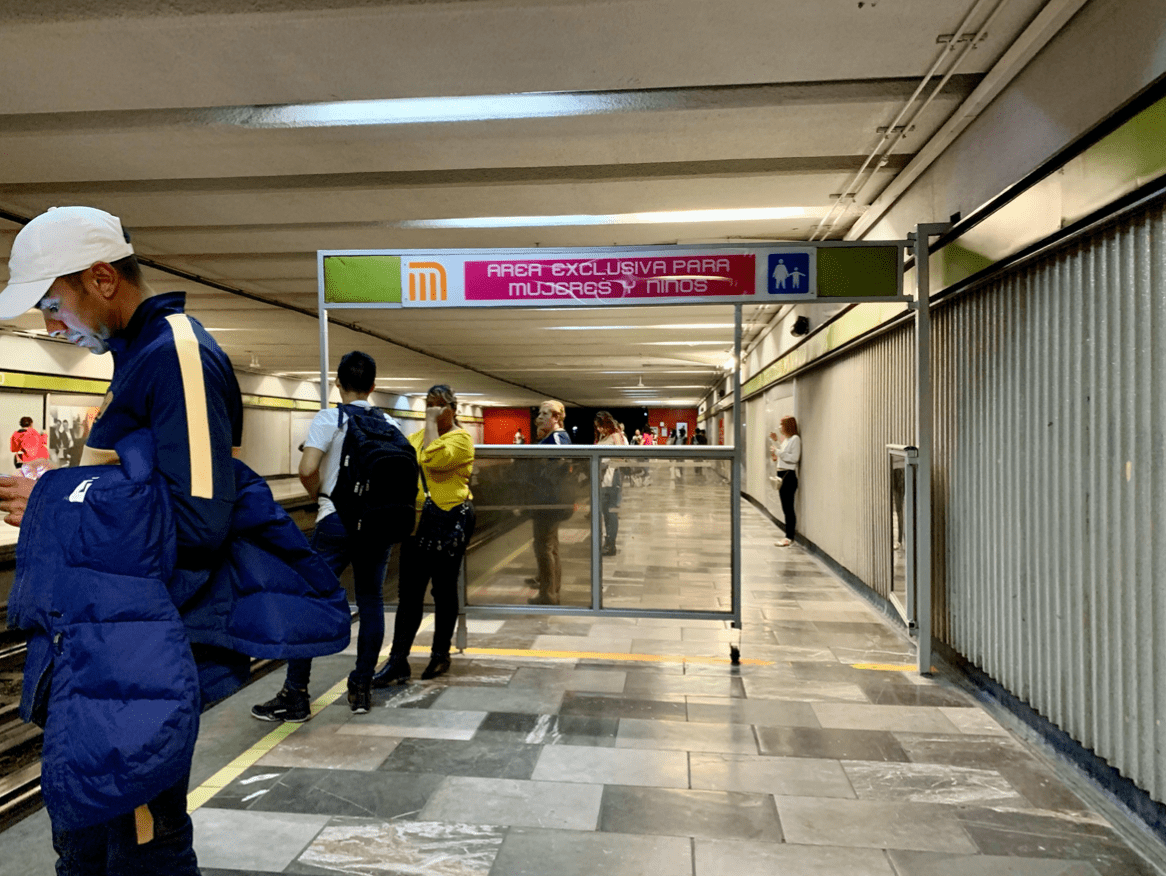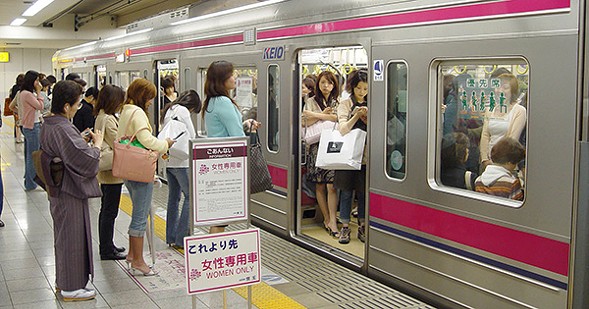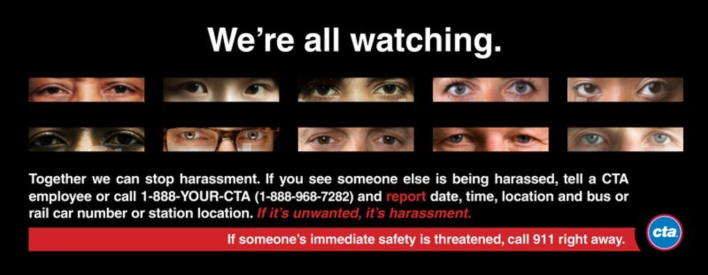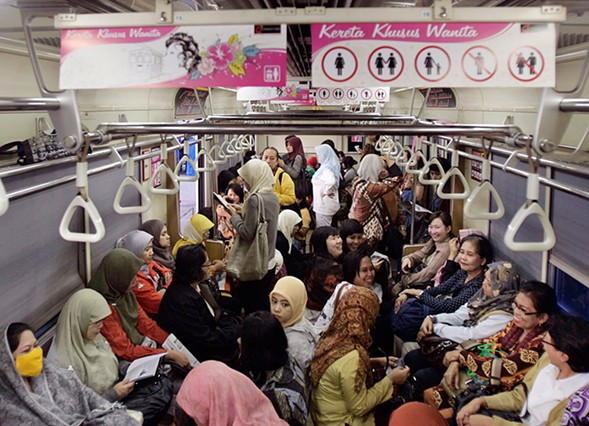Should the CTA adopt women-only transit? Interviews with Chicago women suggest yes
6:08 PM CST on January 15, 2021

Boarding platform for women-only train cars in Mexico City. Photo: Olivia Grenzebach
It is well known and well documented that women often face sexual harassment, or even violence, on public transportation. Women are not always safe and do not often feel safe on public transit, and often choose other modes, like private cars, taxis, or ride-ride, or simply opt to not travel at all. In this way, women do not have equal or equitable access to urban mobility or the city they live in.
This is true across the world, in nations with extreme levels of gender inequality, as well as countries that are often as having evolved past gender inequality. This is certainly true in Chicago and on the CTA. To mitigate actual and perceived risks for women in transit spaces, design strategies can be effective, but are not all equally effective.
In many cities around the world, design strategies and transportation options have been implemented in an effort to ensure women’s safety and comfort on public transportation. A common tactic is women-only transportation. Women-only transit services are most popular in Asian countries, but also exist in South America, Africa, and Europe. Mexico City is the only North American city to offer women-only transit options.

Other strategies have been used in Chicago and other U.S. cities to prevent harassment, violence, and other criminal activity, although in Chicago they're not specifically geared towards helping women. Bright lighting, anti-harassment awareness campaigns, security cameras, increased policing, arrival time tracking, emergency call buttons, and emergency hotlines are ideas that have been tried, with mixed success.
This past year, I researched how women’s safety and perceptions of safety could be improved throughout the CTA system. The main research I did was qualitative data collection through individual interviews with seven female transit users in Chicago, exploring their past experiences and perceptions of safety when using the CTA and their attitudes towards possible design interventions. The research aimed to answer the overarching question, what design strategies can be effective to help ensure women’s safety and feelings of safety when riding transit in Chicago?
Participants were asked specifically about the following strategies, frequently discussed and evaluated in previous literature: lighting; security cameras and closed-circuit TV; reliable arrival time information; emergency call buttons; call and text hotlines; exact location stop requests for buses; customer assistant staff presence; security guard and/or police presence; public awareness and education campaigns; penalties and fines for harassment; and women-only transportation services.

Participants were asked how well they feel each of these strategies would work to make them feel safe, and which would be more effective than others. In all interviews, women-only transit emerged as a key, yet complicated topic. Although that would be a drastic measure, research indicates that it might be effective in ensuring women’s safety and comfort when using public transportation.
Women-only transit findings
Out of the seven women interviewed, six said they would support women-only transit on the CTA. Only one interviewee was against the idea, citing taxpayer costs and the need for other improvements to the system that she saw as higher priorities. However, the same respondent said she would use women-only train cars or sections in "extreme cases." This respondent also noted that women-only transit could help other women, even if it wouldn’t be effective in increasing her own feelings of safety during daytime commutes.
All seven interviewees said that if women-only transportation was an available option, they would, at least sometimes, use it. Most interviewees responded that the presence of women-only cars would make them feel safer and more comfortable, even if they didn’t use them all the time or at all. Most interviewees noted certain situations where they would use women-only cars, like at night, if they were alone, or if they felt threatened at a specific moment. Most interviewees said women-only transit might influence their travel decisions, for example whether to take public transit or take car-based transportation.
While most of the respondents were supportive of the idea, they didn't have express feelings about the subject. One woman said, “It’s more a question of ‘to what degree’ I would feel safer” than whether women-only transit would make her feel safer.
Another woman brought up some possible drawbacks of the strategy. “I wouldn’t want to feel like I always had to ride the women’s car," she said. "I also wouldn’t want it to turn into [a situation] where I want to use the co-ed one, but now I feel unsafe because it’s literally all men in there.” This woman worried that women-only transit could help to normalize gender inequality and inequity, potentially making women more unequal than they are now.
The fact that all the women said they would use women-only transportation, and said it could help women feel safer and more comfortable, but expressed reservations about how it would work, is possibly partly due to the newness of the idea in Chicago. Most interviewee had never heard of the strategy before before. This uncertainty also likely stems from the X factors involved in implementing this idea on the CTA.

Irwin Fedriansyah/AP
Conclusions
The key finding from this research is that women in a U.S. city would feel safer and more comfortable using public transportation if a women-only option was available. Regardless of question and concerns about logistical implementation, and the cultural implications around gender segregation, they believed women-only transportation could be effective.
If implemented on the CTA, Chicago women would have broader mobility and freedom to access their city. In addition, a women-only transportation option would increase transit ridership by encouraging women to use transit in situations, such as when traveling alone at night, nighttime, where they would have otherwise felt unsafe or uncomfortable on an 'L' train.
On a larger scale, the United States needs to experience a massive cultural and societal shift to eradicate gender violence, discrimination, and inequality. But we aren’t there yet, and we probably won't be there all that soon. But women-only transit is something we can do in the near term to help women feel more secure and confident in public space.
True, women-only transportation is only addresses a symptom of a much greater and deeply embedded problem, but it still is helpful. As Leslie Kern wrote in her book Feminist City, “A feminist city must be one where barriers—physical and social—are dismantled, where all bodies are welcome and accommodated.” Women-only transportation helps to dismantle one of the barriers that women face daily, so it should be seriously considered in the Chicago and other U.S. cities.
Stay in touch
Sign up for our free newsletter
More from Streetsblog Chicago
Which Metra corridor would become more bike-friendly and greener under a new plan? Ravenswood!
Thanks to plans to convert little-used parking spaces, the avenue is slated to get a new bike lane, and the Winnslie Parkway path and garden will be extended south.
They can drive 25: At committee meeting residents, panelist support lowering Chicago’s default speed limit
While there's no ordinance yet, the next steps are to draft one, take a committee vote and, if it passes, put it before the full City Council.
One agency to rule them all: Advocates are cautiously optimistic about proposed bill to combine the 4 Chicago area transit bureaus
The Active Transportation Alliance, Commuters Take Action, and Equiticity weigh in on the proposed legislation.



